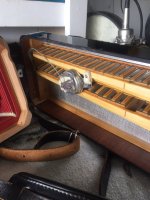jaye deluxe
Newbie
Hi all, I'm new to accordions, new to this group, and appreciate the chance to learn. I came across a Sonola Rivoli R241, which has an internal mic with a 1/4 in. guitar cable. I think this is a factory set up ? What I have found is that the placement of the internal mic makes the center F# sound terribly screechy. Has anyone else had this issue ? And what is the remedy ? Move the mic ? I thought of maybe some kind of baffle ? Thoughts ? Thanks !!!

